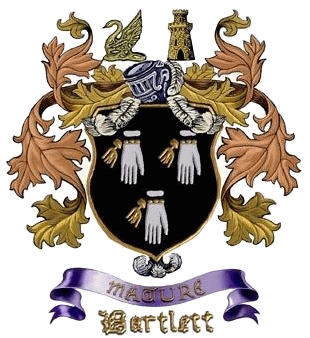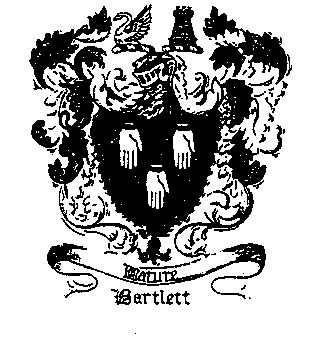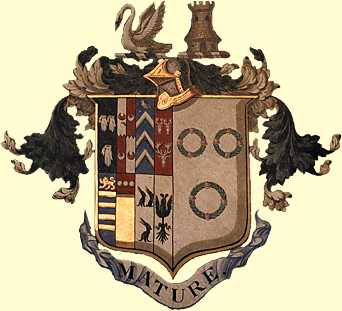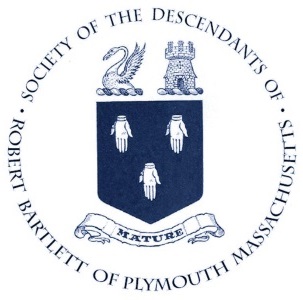The ancestry of Robert Bartlett is still unproven
In 1959 The American Genealogist [volume 35, page 214] published “Possible Origin of Robert Bartlett of Plymouth”, by John G. Hunt, B.S.C., of Arlington, VA. He suggests Robert Bartlett “may well have been that Robert Bartlett baptized in 1603 at Puddletown.”
Expanding on Hunt’s work in 1979, Paul W. Prindle, F.A.S.G. writes “The Probable Ancestry of Robert Bartlett of Plymouth” in The American Genealogist [volume 55, page 164]. In it Mr. Prindle identifies Robert as being the son of Robert & Alice (Barker) Bartlett, who was baptized 27 May 1603 at Puddletown, County Dorset, England.
The main line of the Bartlett Family in England originated in Stopham in County Sussex. The family lived there since the days of William the Conqueror. Prior to the above articles, it was believed that Robert came from Sussex because the fireback, used in the house he built, was thought to have come from the Sussex Ironworks. This fireback has recently been discovered to have come from the Saugus Ironworks in Saugus, Massachusetts. Ongoing work in England has led to the belief that the Puddletown Bartletts are a branch of the Bartletts of Sussex.
However, DNA research does not substantiate this conclusion at this time. The Bartlett DNA Project is open to all males with the Bartlett surname or variants who would like to participate.
Robert Bartlett came to Plymouth Colony aboard the ship Anne in July 1623. Among the other passengers on this ship was his future wife, Mary Warren, daughter of Richard Warren.
Richard Warren had preceded his family to New England, arriving on the Mayflower in 1620.
Robert Bartlett and Mary Warren were married in Plymouth in 1628. The young couple built their home south of the Warren estate between Eel River and the Pine Hills. There they raised their family of eight children, our ancestors.
Bartlett Family Arms
 The Bartlett Family Arms consists of a shield in “sable” (black) with three falconer’s sinister (left hand) gloves about the wrists, arranged triangularly, two at the top, one at the bottom. The Motto is “Mature.” The Crests are a swan argent (white), crouched with wings expanded in dorso, and a castle with three turrets, sable (black).
The Bartlett Family Arms consists of a shield in “sable” (black) with three falconer’s sinister (left hand) gloves about the wrists, arranged triangularly, two at the top, one at the bottom. The Motto is “Mature.” The Crests are a swan argent (white), crouched with wings expanded in dorso, and a castle with three turrets, sable (black).
In the fifteenth century, a castle appears as the crest of this family granted by Edward the Black Prince to John Barttelot for taking the Castle of Fontenoy in France. In the sixteenth century a swan was granted by the Garder King of Arms. Since that date the double crest of the swan and the castle has been used.
Note: When asking permission of Peter Bartlett of Australia who used the above image in one of his several Bartlett websites, he replied (in part) with the following:
“I have no objection to you using the coat of arms or crests since I have always maintained the Robert of the Anne was from our Dorset branch of the Bartlett bloodline. I make the point, though, that in Dorset we have always kept traditionally to only displaying the three left-hand inverted gloves with tassels (without quarterings) because it is believed that to be the original charges bestowed (mythically!) by Charlemagne. Other branches rooted in other parts of England have sometimes adopted other individual variations, but in Dorset, Somerset and Spain (where there is a vast Spanish branch, would you believe) the original has been adhered to…”
A Word About Coats of Arms
 Coats of Arms were never granted to a family. They were always granted to a specific person. In medieval times it denoted the ability to raise an army. Later it was a mark of distinction that was taxed. Arms are inheritable, but only to the eldest surviving son. Lesser sons and all daughters were issued arms with differences.
Coats of Arms were never granted to a family. They were always granted to a specific person. In medieval times it denoted the ability to raise an army. Later it was a mark of distinction that was taxed. Arms are inheritable, but only to the eldest surviving son. Lesser sons and all daughters were issued arms with differences.
Our government does not recognize the awarding of Arms. Americans have been confused into believing that arms are inheritable through families. This is because the early genealogies in England traced landed families in England in which the inherited arms was a means of showing the connection to that family. They did not show families where the husband adopted a wife’s arms (which she herself could not hold) or where the design of the arms radically changed.
The Bartlett Coat of Arms shown in the color picture below is the arms of the Lords of Stopham, Sussex. To the best of our knowledge neither Robert Bartlett nor any of his descendants, who lived in colonial times ever claimed a right to it. One of the descendants of Richard Bartlett (see “Other Bartletts” for Richard’s genealogy) is said to have the arms carved on their colonial headstone. If his claim to these arms is genuine then Richard Bartlett would have a closer tie to the Lords of Stopham than Robert appears to have.

This Bartlett Family Arms shown above is enhanced from a photograph of a tapestry in Stopham, England.
The Bartlett Family in England
The Bartlett family, by tradition, is said to have been founded by one Adam Barttelot who was esquire to Guido de Brionne (or de Bryan). That lord came from the Liseux district of Normandy to England with William the Conqueror.
When the Conqueror divided the lands that he conquered he gave Sussex to Earl Roger de Montgomerie. Tradition states that Adam Barttelot settled in Stopham and received lands there from his companion in arms, Earl Roger de Montgomerie. The Earl also gave the town of Stopham, in the Rape of Arundel and the Rotherbridge Hundred, to one Ralph. This was before surnames came into prominence. This Ralph took the name of that place as his surname and was seen living in Stopham in 1248 and was either the father of or identical with Sir Ralph de Stopham, who died in Stopham in 1271/2.
One descendant of this Adam Barttelot, John Barttelot, obtained a third of the manor of Stopham through his marriage with Joan de Stopham at the close of the Fourteenth Century. The manor was reunited in 1555 when William Barttelot purchased the remaining two-thirds. Thus they became the Lords of Stopham.
Much of this account has been taken from Dudley George Cary Elwes’ book A History of the Castles, Mansions and Manors of Western Sussex (1876). Also The Visitations of the County of Sussex by Bruce Bannerman, published in The publications of the Harleian Society (Vol. 53 pg. 220 – 1905].
